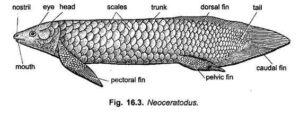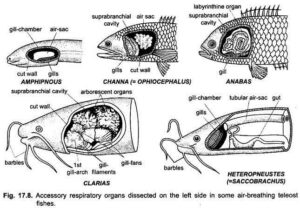Back to: ZOOLOGY 300 Level
WELCOME TO CLASS!
You’re showing great consistency, and I’m glad to have you back. Today’s topic brings us even closer to understanding the daily life of fish—how they move, breathe, and protect themselves. We’ll be learning about fins, respiration, and scales, three key features that every fish uses to survive in its aquatic world.
Fins, Respiration, Scales
Imagine you’re sitting beside a river in Cross River State or watching fish in a transparent tank at the market in Ibadan. You’ll notice they move with ease, breathe without lungs, and are covered in shiny protective layers. What’s behind all of that? Let’s find out together.

Fins
Fins are to fish what legs and arms are to us—they’re used for movement, balance, direction, and even defence in some species.
There are two main types:
- Paired fins: These include the pectoral fins (on the sides) and pelvic fins (below the body). They help with steering and stability.
- Unpaired (median) fins: These include the dorsal fin (on the back), anal fin (under the body near the tail), and caudal fin (tail fin). These help with propulsion, balance, and sudden movement.
Let’s break it down further:
- The caudal fin is the powerhouse, used for forward motion.
- The dorsal fin helps keep the fish upright, like a ship’s stabiliser.
- The pectoral fins are like paddles, allowing turning and slowing down.
In Nigerian rivers, catfish use their pectoral fins not just for swimming but also to “walk” along the bottom in muddy areas. Some fish even have spiny fins to protect themselves from predators.
Respiration
Fish don’t have lungs like us, but they still breathe efficiently—thanks to gills.
Here’s how it works:
- Water enters through the mouth and passes over the gill arches.
- These arches have gill filaments rich in blood vessels.
- Oxygen from the water moves into the blood, and carbon dioxide leaves the blood into the water.
This gas exchange happens through a process called counter-current exchange, where blood and water flow in opposite directions for maximum oxygen absorption.
Some fish, like the African catfish, have an accessory breathing organ that allows them to breathe air during dry seasons or in poorly oxygenated water. This is one reason why catfish can survive better in Nigerian ponds and swamps where oxygen levels are low.
Scales
Fish scales are like a flexible, shiny armour that protects the skin from injury, parasites, and infections. They also reduce friction, helping fish glide smoothly through water.

There are different types of scales:
- Cycloid and ctenoid scales: Found in most bony fish like tilapia and perch. Cycloid scales are smooth, while ctenoid scales have tiny teeth on their edges.
- Ganoid scales: Thick, shiny, and diamond-shaped, found in fish like gars.
- Placoid scales: Found in cartilaginous fish like sharks and rays—these are tough, tooth-like scales that also reduce drag.
Many Nigerian fish species used in local dishes (like smoked tilapia or catfish pepper soup) have cycloid or ctenoid scales. You’ve probably scraped them off with a knife before cooking!
Scales also carry growth rings, like tree trunks. Scientists can use these to estimate a fish’s age.
Summary
- Fins help fish swim, steer, and stay balanced. They are either paired (like pectoral) or unpaired (like dorsal and caudal).
- Respiration in fish occurs through gills, using a highly efficient oxygen-exchange system.
- Scales protect the fish’s body and help with smooth movement; they come in different shapes and textures depending on the species.
Evaluation
- What is the function of the caudal fin in fish?
- Describe how fish extract oxygen from water.
- What are two types of fish scales and which fish have them?
- How do cartilaginous fish scales differ from those of bony fish?
- Mention one fish adaptation for breathing in low-oxygen environments.
You’re becoming more aware of the inner workings of aquatic life, and it’s amazing how each feature in fish is specially designed for life in water. The knowledge you’re building now is the foundation for careers in marine biology, aquaculture, and conservation. Keep that passion burning—we’re going even deeper in the next class!
